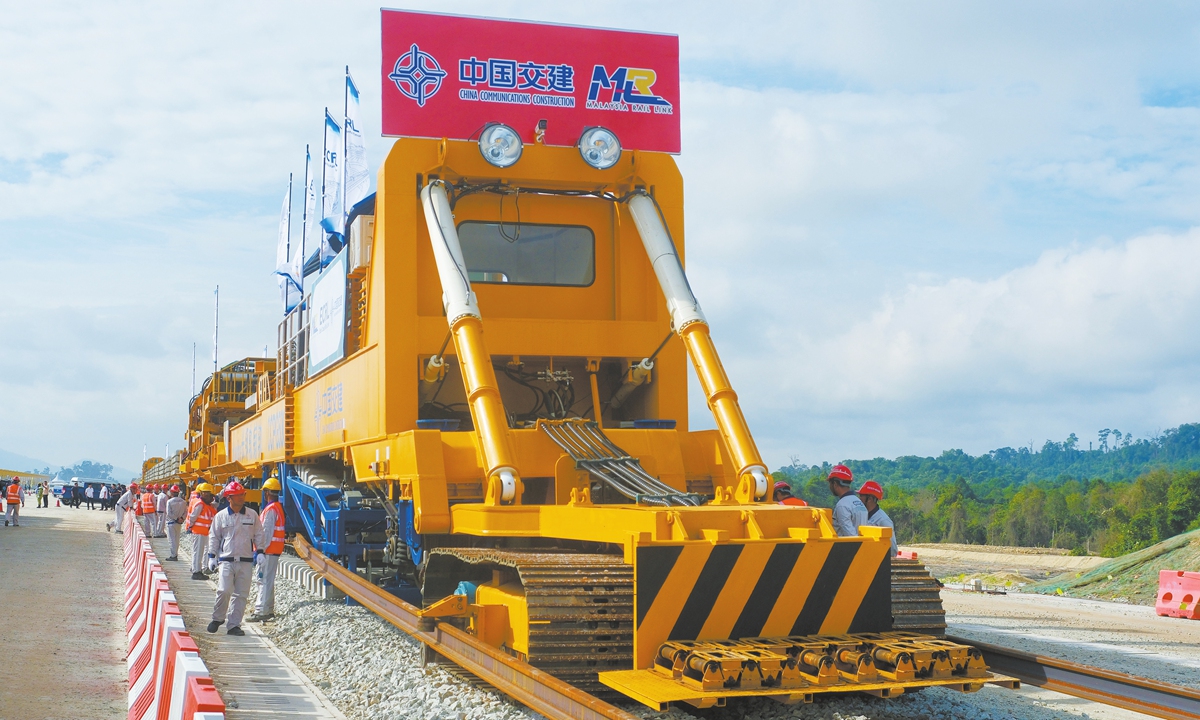
The first tracks of the East Coast Rail Link project are laid at the launching site in Kuantan, Malaysia, on December 11, 2023. Photo: VCG
Editor's Note:Chinese President Xi Jinping began his three-day visit to Malaysia on Tuesday, following his visit to Vietnam. This head-of-state diplomacy underscores China's long-term commitment to deepening all-around cooperation with neighboring countries to safeguard peace and stability in the region and beyond. Global Times (GT) reporters Wang Wenwen and Xing Xiaojing interviewed Peter T.C. Chang (Chang), former deputy director of the Institute of China Studies at the University of Malaya, and a research associate at the China-Malaysia Friendship Association, regarding the advancement of China-Malaysia relations and the exemplary role these relations play in promoting China-ASEAN cooperation amid the changing regional and international landscape.
GT: As a scholar deeply engaged in observing China, how do you evaluate the development journey of China and Malaysia from a "comprehensive strategic partnership" to reaching a consensus on jointly building a "China-Malaysia community with a shared future"?Chang: In 2013, China-Malaysia relations were elevated to a comprehensive strategic partnership. In 2023, the two countries reached a consensus on jointly building a China-Malaysia community with a shared future, marking an important milestone in the development of bilateral ties. Political mutual trust between the two countries has been deepened, economic integration has continued to strengthen, and cultural exchanges have grown increasingly close.
This progression aligns with China's broader vision of fostering win-win cooperation and regional stability under initiatives like the Belt and Road Initiative (BRI). Malaysia's pragmatic engagement, particularly in infrastructure and trade, has strengthened mutual benefits while balancing regional geopolitics.
The shift, in my assessment, underscores the ability of Chinese and Malaysian leadership to adopt a long-term vision and the willingness to set aside differences in pursuit of the greater common good. Overall, it marks a maturing relationship with significant potential for both nations.
GT: How do you view the exemplary role of the China-Malaysia relationship within the broader China-ASEAN relationship? Given the complex and evolving international situation, what role can stable China-Malaysia relations play in the conduct of neighborhood diplomacy? Chang: China-Malaysia relations serve as a strong example of cooperation within China-ASEAN ties, demonstrating how mutual respect and shared development can foster regional stability and prosperity. As a key ASEAN member, Malaysia's close partnership with China - marked by strong economic ties, infrastructure collaboration and cultural exchanges - helps anchor China-ASEAN relations, promoting dialogue and unity amid global uncertainties. The two countries' ability and willingness to set aside differences for the sake of the greater common good demonstrate how trust and win-win cooperation can overcome geopolitical complexities and enhance regional resilience.
Looking ahead, I believe our bilateral relationship can exemplify the vision of "a community with a shared future" by advancing inclusive growth, multilateralism and people-to-people connectivity. By deepening collaboration in green development, the digital economy and security, China and Malaysia can inspire broader regional and global solidarity.

Peter T.C. Chang Photo: Official website of the University of Malaya
GT: Malaysia is the rotating chair of ASEAN this year. How can we take this opportunity to safeguard peace and promote development in the Asia-Pacific region? In light of unilateralism and trade coercion by certain countries, how can China and ASEAN respond to these challenges?Chang: As ASEAN chair this year, Prime Minister Anwar Ibrahim is showcasing Malaysia's readiness to leverage its leadership to strengthen regional cooperation by promoting dialogue, confidence-building measures, and inclusive economic initiatives within the Asia-Pacific. China and ASEAN should jointly uphold multilateralism, resist unilateralism, and advocate for peaceful dispute resolution through platforms such as the ASEAN Regional Forum and the East Asia Summit.
Amid ongoing geo-economic upheaval, China and ASEAN should adopt a coordinated strategy to counter the latest tariffs imposed by the US administration by deepening their economic ties and strengthening regional trade agreements. For example, by optimizing the ASEAN-China Free Trade Area and fully implementing the Regional Comprehensive Economic Partnership, both parties can reduce our reliance on the US market and mitigate the impact of the tariffs. Joint initiatives, such as diversifying supply chains within the region, promoting intra-ASEAN trade and leveraging alternative markets, can help both sides buffer against economic disruptions.
GT: Malaysian Prime Minister Anwar has repeatedly stated that his country will not "take sides." How can ASEAN countries balance their foreign policies amid great-power competition? What common understandings and actions do China and Malaysia share in upholding ASEAN's strategic autonomy?Chang: This year marks the 70th anniversary of the Bandung Conference, which laid the foundation for the Non-Aligned Movement - of which most ASEAN members are a part.
In that spirit, ASEAN countries, including Malaysia, continue to balance their foreign policies amid great-power competition by upholding neutrality, inclusivity and economic pragmatism, thereby preserving strategic autonomy while constructively engaging with all major powers. The principle of ASEAN centrality is crucial to this balancing act, as it upholds the region's strategic autonomy. In my view, China both understands and supports this core doctrine.
For example, China's backing of ASEAN-led multilateral frameworks reinforces the bloc's collective voice and helps resist external pressures to take sides - aligning with Malaysia's stance of "not choosing sides" while pursuing shared development.
China and Malaysia share a strong commitment to promoting dialogue over confrontation and to the peaceful resolution of disputes. This shared approach, I believe, contributes to regional stability and supports deeper economic integration through initiatives such as the BRI and the ASEAN-China Free Trade Area.
GT: What specific impacts have been brought to the local area in Malaysia by the implementation of BRI projects such as the East Coast Rail Link (ECRL)? With the increasing maturity of local innovation and the expanding consumer market in Malaysia, what new fields are likely to emerge as economic growth points for both countries in the future?Chang: The impact of BRI projects, such as the ECRL in Malaysia, is momentous. It has significantly improved infrastructure connectivity, particularly between the east and west coasts, stimulating regional development and reducing logistics costs. The project has created job opportunities, attracted foreign investment, and boosted the tourism and construction sectors in less-developed regions of Peninsular Malaysia.
As Malaysia's local innovation ecosystem matures and its consumer market grows, future economic growth between China and Malaysia is likely to emerge in high-tech industries such as green energy, the digital economy and smart manufacturing. Additionally, sectors like e-commerce, fintech and biotechnology present promising areas for collaboration. These developments not only deepen bilateral ties but also accelerate Malaysia's adaptation to industrial revolution 4.0 technologies and its transition to a more knowledge-based economy.
GT: China and Malaysia have implemented a mutual visa-free policy. What role has this policy played in promoting economic and trade exchanges, as well as people-to-people and cultural exchanges between the two countries?Chang: I believe the mutual visa-free policy between China and Malaysia is one of the most significant foreign policy initiatives in recent decades.
The visa-free agreement has significantly enhanced economic, trade and cultural exchanges by making travel more convenient and encouraging greater mobility between the two nations. It has boosted tourism, with more visitors contributing to local economies through spending on hospitality, retail and transportation. The policy also facilitates easier business travel, strengthening trade partnerships, investment opportunities and collaboration in sectors such as manufacturing, technology and services.
Moreover, it fosters deeper people-to-people ties and cultural understanding, as increased interactions through tourism, education and cultural exchanges help build mutual trust and long-term cooperation. This policy reflects the growing strategic partnership between the two countries and supports broader regional integration efforts.





